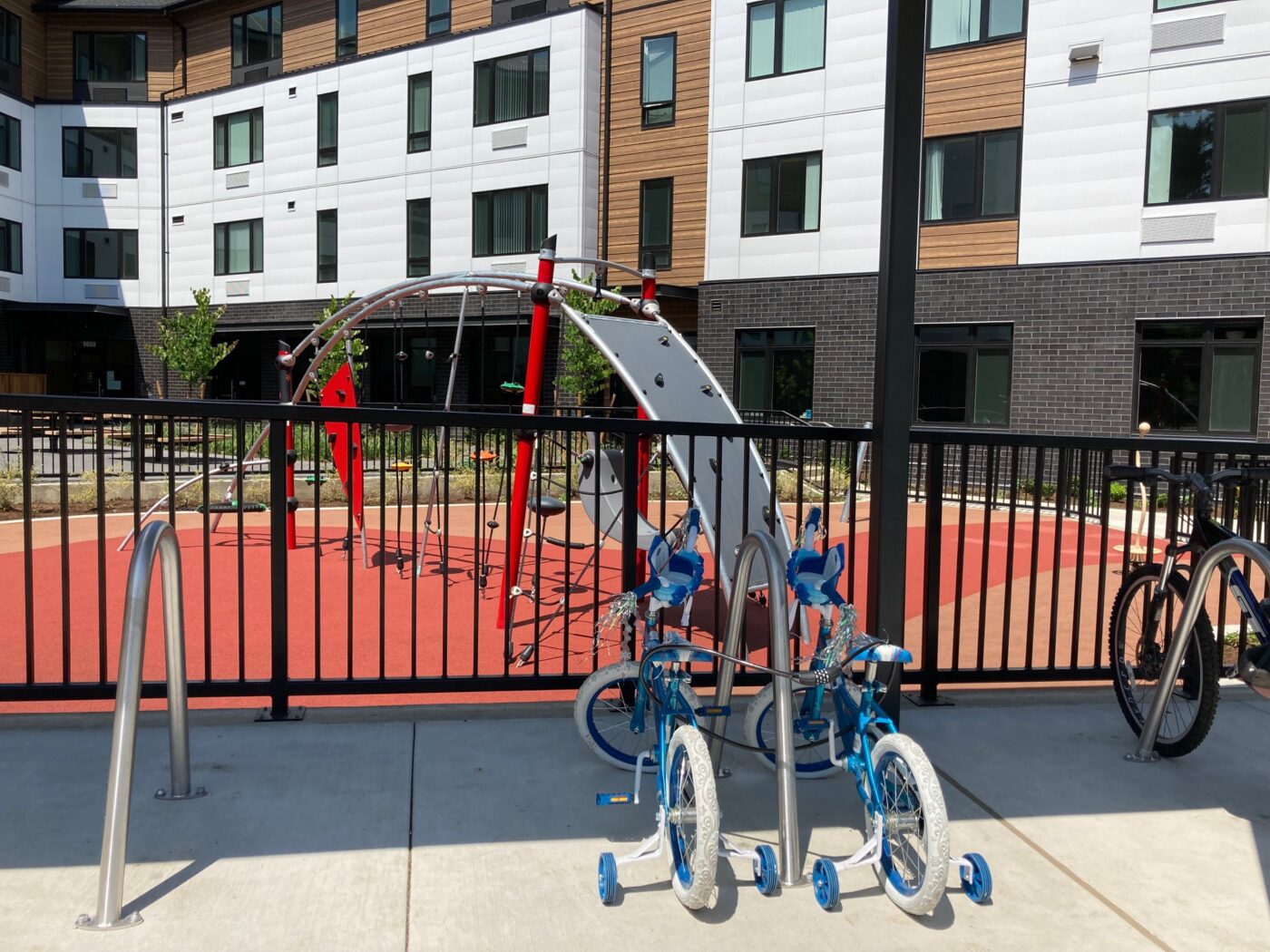 Playground in Terrace Glen apartments on SW Greenburg Rd, in Tigard. (Photos: Lisa Caballero/BikePortland)
Playground in Terrace Glen apartments on SW Greenburg Rd, in Tigard. (Photos: Lisa Caballero/BikePortland)
The push to encourage residential building is not very tightly joined to the moral imperative of making our region a safe place to get around on foot, bike — or while waiting for a bus. Our governments offer financial incentives to build the buildings, but you are too often on your own once you leave the property.
What good is new housing if it’s too dangerous to leave in anything other than a car — the most expensive transportation option available?
I was reminded of how transportation funding is a weak link in our system when I filled out my Portland Bureau of Transportation budget and revenue survey. It read like a push poll. Money is short, there isn’t anything you want to cut, and PBOT is mostly funded with gas taxes and parking fees — the survey made sure you didn’t leave without understanding those things.
But transportation in the region as a whole is in the midst of a funding reckoning, not just in Portland. Stepping away from Portland politics might make the big picture easier to see, and that’s where Tigard and Washington County come in.
 Bus stop on SW Greenburg Rd, with the Terrace Glen apartments in background. Looking north, from SW Lehman St.
Bus stop on SW Greenburg Rd, with the Terrace Glen apartments in background. Looking north, from SW Lehman St.
Earlier this year, BikePortland reported that Washington County had decided to close its budget gap with general fund money historically reserved for transportation. The loss of MSTIP (Major Streets Transportation Improvement Program) funding immediately jeopardized the 25 large capital projects which area transportation agencies had submitted for the current funding cycle, and even imperiled shovel-ready projects which had already been approved in previous cycles.
Tigard’s planned Complete Street overhaul of SW Greenburg Rd was one of those affected projects. Greenburg runs just east of Washington Square Mall and borders the western edge of the Metzger neighborhood, whose residents would be vulnerable to displacement with gentrification. Greenburg doesn’t have bike lanes or continuous sidewalks, it is difficult to cross, and the volume and speed of car traffic make it an autocentric barrier dividing Metzger from the mall. The Complete Street project would have transformed the road with crossings, protected bike lanes and continuous sidewalks.
Greenburg also happens to be the site of a newly completed Metro-supported subsidized housing development. Officials cut the ribbon on Terrace Glen just last month. It has 144 affordable apartments and boasts that it is adjacent to,
retail, grocery, rapid public transit and entertainment … Retail amenities include Washington Square Mall with its entertainment and recreation hub, directly across the street from the site. TriMet stops across the street provide direct access to Beaverton Transit Center and other destinations.
Here’s the thing though, you can’t safely cross Greenburg from Terrace Glen to reach all that retail and public transit. And the bus stop mentioned in the quote above (and pictured in photo above) doesn’t have a sidewalk anywhere near it and is only a couple of feet, and one shallow curb, away from a stroad with a posted speed of 35 mph.
So the affordable housing got built, but with the Tigard’s Greenburg complete street project on indefinite hold, it is unfortunately not safe to leave Terrace Glen except by car.
The total development cost of Terrace Glen was $51.2 million, $17.5 million came from the Metro Affordable Housing Bond. And here’s what caught my eye, Terrace Glen also received a half a million dollars in TOD funds (Transit-Oriented Development) which are specifically targeted to “stimulate private sector investment” and “increase opportunities for people live, work and shop in neighborhoods with easy access to high-quality transit.” Without the Greenburg Complete Street improvements, however, Terrace Glen does not have “easy access” to transit, it is just another apartment building on an unsafe road. Albeit one that is affordable.
TOD money is a carrot to get developers to build affordable housing in transit-rich and walkable areas, but it is not meant for actually building anything. Half a million seems like a puny carrot for a $51.2 million project, but it would pay for a crosswalk and flashing beacon.
But there is not a bad guy here, and I’m not pointing a finger. This disconnect between development and transportation infrastructure is the result of piecemeal and inadequate transportation funding. Executing everything according to plan with Terrace Glen would have required glitchless coordination between Metro, the City of Tigard, Washington County and the developer — and more money for transportation. We need to do better and get both the housing and the transportation pieces right.


